New Kosciuszko Bridge Replacement
June 1, 2017
The New York State Department of Transportation decided to replace in full the aging Kosciuszko Bridge which carries the Brooklyn-Queens Expressway (I-278) over Newtown Creek, connecting Brooklyn and Queens. The current design build contract was awarded to Skanska Kiewit Ecco III Joint Venture (SKE) with HNTB as the project team’s design firm. LiRo is the project’s on-site Quality Control Team for SKE during construction, in coordination with the NYSDOT and their Director of Construction Bruce Ogurek PE, and Project Director Robert Adams PE.
At $555 million, the Kosciusko Bridge Replacement is the largest single contract in the history of the NYSDOT and is the first cable-stayed bridge in New York City. The overall replacement project will be built in two phases. Phase I includes the construction of a new eastbound bridge and the demolition of the existing bridge. The eastbound bridge is being built adjacent to the existing structure to minimize traffic disruption. It will be wide enough to accommodate both directions of traffic during the demolition of the existing bridge and the construction of the new westbound bridge. The eastbound Bridge is on track to open in early 2017 and the demolition of the existing Kosciuszko Bridge will begin thereafter. The construction of the westbound bridge will take place in Phase II of the project and will be administered under a new DOT contract. Construction of the westbound bridge is proposed to begin in the spring of 2018.
LiRo’s services for Phase I of the project include oversight and quality control for the new construction of a 1,000 ft cable stayed main span, approaches, Brooklyn connector ramps, Queens connector ramps, Long Island Expressway ramps, portions of the Meeker Avenue Viaduct, a pedestrian bridge, bridge drainage system, and the demolition of the existing structure.
New York City is known for its suspension bridges but the new Kosciuszko Bridge has a cable-stayed main span. Why was this design chosen?
A cable stayed structure was chosen over a suspension bridge because it is a more efficient design for a span of this length (app. 1,000 ft). It is more efficient in the sense that the self-balancing nature of this type of structure eliminates the needs for massive and expensive main cable anchorages that are required in suspension bridges. Additionally, with today’s better construction materials and advanced engineering knowledge, a cable stayed bridge is typically faster to build, which in turn makes it a more cost effective structure.
The old Kosciuszko Bridge was notorious for traffic jams and branded with one of the highest accident ratings amongst NYC bridges. How will the new bridge ease those problems for motorists commuting to and from Brooklyn and Queens?
The new bridge(s) will ease traffic and increase driver safety by featuring approaches with more gradual inclines, additional and wider travel lanes and shoulders than what exists with the current bridge. These features will provide better sight lines for drivers and also make it easier for trucks to maintain their speed while approaching the bridge as well as recovery areas. The steep approaches on the existing bridge slow down trucks, which is one of the main causes of current traffic jams.
Providing quality control on such a massive and important infrastructure project takes strict regulations. What are LiRo’s best practices to make sure that the 300 employees working on this job follow protocol?
LiRo’s approach to ensuring the client is provided with a high quality product starts with having a knowledgeable and talented staff. With over 20 engineers and technicians on site full time, we are able to ensure the project is built properly and safely. Our diverse team at the K-Bridge ranges from young graduate engineers to project managers with over 30 years of experience in the industry. We recognize that the entire team must always be advancing their knowledge and skillsets which is why we have brought in industry experts and have sent staff around the country for training on the unique and technical methods used to construct this type of structure. In particular, the Main Span primary crew is made up of young, insightful engineers and technicians: John Rago – lead, Delwyn Diano, Nicholas Gulino, Craig Laudani, Brett Varjas and Dean Zeffer.
This profession can sometimes mean working long hours, in all weather conditions, to ensure that a project stays on time and within budget. What do you find most rewarding from such a demanding job?
John Rago: For me, there are two things that make the long, and at times, uncomfortable hours this job demands worth it. The first thing is seeing the progress of the hard work put in by myself and my co-workers as we watch the bridge grow larger and more impressive with every passing week. The second is knowing that for the rest of my life, I will be able to say that I was involved in the creation of this structure which changed the New York City skyline and which is relied upon by millions of people every year. In the future, each time I drive over the bridge I’ll be reminded of all I learned during its construction, the tiny details the public may never notice, and the memories I shared with the rest of the design-build team.
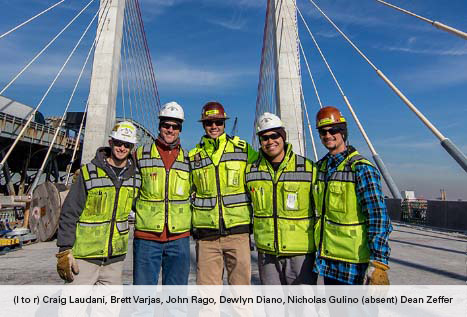
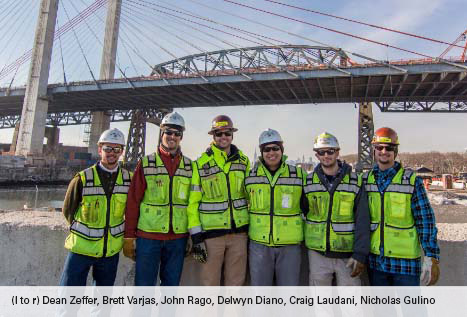
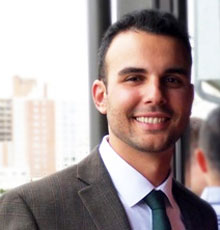
John joined LiRo as a recent graduate in 2010. Since then he has worked on prominent projects within the NYC area including the Queens Plaza Streetscape, the replacement of the existing water siphons between Brooklyn and Staten Island, and the Metropolitan Avenue Bridge rehabilitation. He currently works on the Kosciuszko Bridge Replacement where he is the quality control team leader and manager on the main span portion of the project. While on the K-Bridge John acquired his professional engineering license, and has taken courses in cabling and post tensioning, making him an expert in Cable Stay construction.
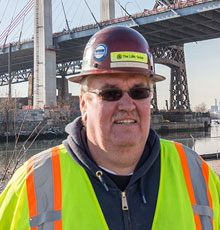
Prior to joining LiRo in 2008, Tom had a 25 plus year career with the New York State Department of Transportation where he worked on a wide variety of major infrastructure projects within the New York metropolitan area, including the management multiple projects for Route 9A in Manhattan, the FDR Drive and the Queensboro Bridge. His projects with LiRo have included the No. 7 Line Subway Extension and the Replacement of Water Siphons between Brooklyn and Staten Island. In addition, His knowledge of the construction industry, practices and requirements are unmatched.
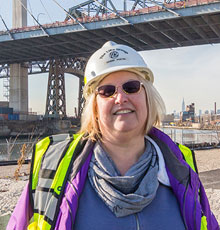
Prior to joining LiRo in 2014, Debbie had a 30 plus year career with the New York State Department of Transportation where she held several design and construction roles. Her extensive experience included serving as Site Manager Training Coordinator for the State, co-creator of the State Office Engineering Manual and Training Program, Assistant to the Region 10 Construction Engineer for 16 years, EIC of Bridge Rehabilitation projects in R11, Assistant to Region 11 Director of Engineering and the Region 11 Design Engineer, Project Manager for a multi-million dollar project on the Long Island Expressway, along with various other design rehabilitation projects.




